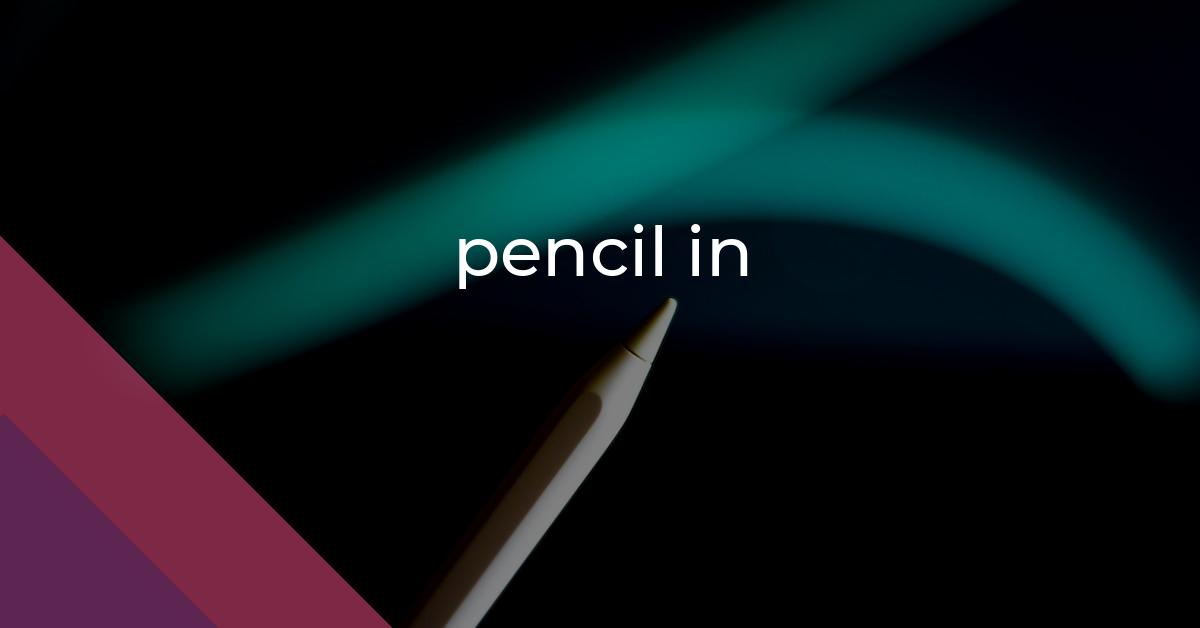pencil in: Idiom Meaning and Origin
What does ‘pencil in’ mean?
"Pencil in" means to tentatively schedule or make a provisional appointment, allowing for changes or adjustments. It suggests that the plans are not set in stone and can be modified. The idiom commonly refers to making plans that may be subject to alteration or cancellation.

Idiom Explorer
The idiom "take into consideration" means to think about or consider something before making a decision or forming an opinion.
The idiom "rough out" means to create a preliminary or unfinished version or plan of something, typically a design, drawing, or outline. It implies a quick and approximate representation that will be refined or polished later.
The idiom "pitch in" means to join in and help or contribute to a task or activity.
The idiom "pin down" means to force someone to make a clear statement or commitment about something, or to accurately determine or locate something.
The idiom "pill in the pocket" refers to having a hidden or secret plan or backup option that can be used if needed.
The idiom *phone in* means to make a telephone call, typically to provide information or participate in a conversation without being physically present.
The idiom *pen picture* is used to describe a vivid and detailed description or portrayal of someone or something, as if it were a picture drawn with a pen. It emphasizes the use of words to create a visual representation.
The idiom "pencil whip" refers to the act of quickly signing or completing paperwork without proper examination or consideration, often done to meet a deadline or appear productive. It implies a lack of thoroughness or dishonesty in the process.
The idiom *peg down* means to definitively establish or fix something, often by securing it firmly. It implies a sense of certainty and stability in setting or determining a particular matter.
A Hidden Notation: Unveiling the Trick!
The idiom "pencil in" is a commonly used phrase in English language. It is used as a metaphorical expression to convey the idea of making a tentative appointment or arrangement. This idiomatic phrase originates from the act of using a pencil to write in a schedule or appointment, which can easily be erased or changed. The phrase has been in use for quite some time and has become a part of everyday language.
The meaning of the idiom "pencil in" is to make a plan or arrangement that is not yet confirmed or finalized. It implies that the arrangement may be subject to change or cancellation pending further confirmation or availability. The idiom suggests a level of flexibility and uncertainty in the arrangement, as if it were written in pencil rather than pen.
This idiom is commonly used in informal and conversational contexts, such as when making social plans, scheduling meetings, or discussing future events. It is often used to indicate that the plans being made are not set in stone and may need to be adjusted based on various factors.
The idiom "pencil in" can also be used figuratively to describe a person's mindset or approach towards making plans or commitments. It suggests a willingness to adapt and be flexible in order to accommodate changes or unexpected circumstances. It can also imply a certain level of informality or lack of commitment to specific plans.
One related idiom is "book in". This phrase is often used interchangeably with "pencil in" to convey the same meaning of making a tentative appointment or arrangement. Just like "pencil in", "book in" suggests that the arrangement may be subject to change or confirmation. Both idioms highlight the importance of flexibility and adaptability when making plans or scheduling appointments.
Another related idiom is "ink in". While "pencil in" and "book in" imply that the arrangement is not yet confirmed, "ink in" is used to convey the idea of finalizing and confirming the plans. When something is "inked in", it means that the arrangement is now set and unlikely to change. This idiom contrasts with "pencil in" and emphasizes the certainty and permanence of the plans.
Similarly, the idiom "make time" is closely related to "pencil in". While "pencil in" refers to making a tentative arrangement or appointment, "make time" refers to allocating or setting aside time for something. It implies that the person is willing to prioritize or adjust their schedule in order to accommodate the activity or event. Both idioms convey the idea of being flexible and willing to make adjustments in order to fit something into one's schedule.
Lastly, the idiom "bring forward" is also connected to "pencil in". When something is "brought forward", it means that the date or time of an appointment or event has been moved earlier. This idiom highlights the idea that plans can be adjusted and rearranged, much like how a pencil can be used to erase and rewrite a schedule. "Bring forward" emphasizes the flexibility and adaptability of making plans and suggests a willingness to change the original arrangement.
Overall, the idiom "pencil in" is a widely used expression that conveys the idea of making a tentative arrangement or appointment that is subject to change or confirmation. It captures the concept of flexibility and adaptability in making plans, while also emphasizing the potential for uncertainty or adjustments. This idiom reflects the dynamics of modern life and the need to be open to unforeseen changes and developments.
Example usage
Examples of how the idiom *pencil in* can be used in a sentence:
- She asked me to pencil in our meeting for next week.
- Can you pencil me in for a haircut on Thursday?
- I had to pencil in my doctor's appointment because I wasn't sure of the exact date.
More "Verbs" idioms



